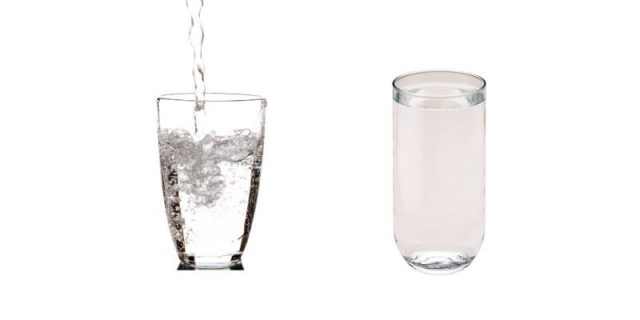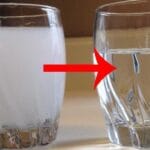Have you ever turned on your tap, only to be greeted by a glass of cloudy water? It can be surprising and a bit unsettling.
Why is your tap water cloudy, and should you be concerned? You’re not alone in wondering about this common issue. Many people experience cloudy tap water and are curious about its causes. Understanding what’s happening can help put your mind at ease and ensure you’re making informed decisions about your water quality.
We’ll delve into the reasons behind cloudy tap water and what you can do about it. Stick around to discover how to ensure the water coming out of your tap is as clear and clean as it should be.
Common Causes Of Cloudy Tap Water
Tap water often appears cloudy due to tiny air bubbles that form in the water. These bubbles create a milky look but usually clear up in a few minutes. Another cause can be mineral deposits from pipes, affecting water clarity.
Have you ever turned on your tap, only to be greeted by cloudy water? It can be unsettling, right? Understanding the common causes of cloudy tap water can help you find a solution. Let’s dive into why your tap water might not be crystal clear.Air Bubbles
Sometimes, the cloudiness in your water is nothing more than trapped air bubbles. This often happens when water pressure changes rapidly. Imagine the rush of water through pipes, creating tiny bubbles that make your water appear cloudy. It’s similar to a soda fizzing when you pour it into a glass. Good news: this is harmless. Let your glass of water sit for a minute. Watch as the bubbles rise and your water clears up. Have you noticed this quick fix working for you?Mineral Deposits
Minerals in your water are another common culprit. Hard water, rich with minerals like calcium and magnesium, can cause cloudiness. These minerals can accumulate, especially if your area is known for hard water. You might have seen this in your kettle or coffee maker, leaving a chalky residue. Installing a water softener can reduce these deposits. Have you considered testing your water for hardness levels?Pipe Corrosion
Older homes often face issues of pipe corrosion. As pipes age, they can rust, releasing tiny particles into the water. This can make your tap water appear cloudy and even taste metallic. If you live in a house built decades ago, this might be your problem. Regular plumbing inspections can catch this early. Do you remember the last time your pipes were checked? Understanding these causes can transform your approach to solving cloudy water issues. The next time you face cloudy tap water, you’ll have a checklist to ensure clear solutions!Effects Of Temperature And Pressure
Cloudy tap water often puzzles homeowners. Temperature and pressure changes can make tap water appear cloudy. Understanding these factors can help you address this common issue.
Temperature Changes
Water temperature affects its clarity. Cold water holds more air compared to warm water. When cold water enters your home, it warms up. This warming releases dissolved air, creating small bubbles. These bubbles make the water look cloudy. It often clears within minutes as the bubbles rise to the surface.
Pressure Variations
Pressure changes also impact water clarity. High pressure keeps air dissolved in water. When pressure drops, air escapes as bubbles. These bubbles cause the cloudy appearance. This is common when opening a tap after long periods of non-use. The water might seem cloudy at first but usually clears up quickly.
Role Of Water Treatment Processes
Understanding the role of water treatment processes is crucial when figuring out why your tap water might appear cloudy. These processes are designed to make water safe and clean, but they can sometimes lead to unexpected outcomes, like cloudiness. Let’s break down how these processes work and their potential impact on your tap water’s clarity.
Filtration Techniques
Filtration is often the first step in water treatment, removing large particles and impurities. Imagine a giant sieve that catches all the unwanted bits. If your water looks cloudy, it might be because tiny particles slipped through the filters.
Different techniques target different contaminants. Sand filters, for instance, are effective for larger debris, while activated carbon filters tackle odors and chemicals. If your water provider uses a specific technique, it could influence the clarity of your water.
Have you ever noticed how certain days your tap water looks clearer than others? This might be due to changes in the filtration process. Understanding these techniques can help you discuss concerns with your water supplier.
Chemical Additives
Chemicals play a pivotal role in ensuring water is safe to drink. Chlorine is a common additive used to kill harmful bacteria. However, it can sometimes react with other substances, causing cloudiness.
Another common chemical is fluoride, added to improve dental health. While it’s beneficial, excess amounts can alter water’s appearance. Think about how your toothpaste foams up; something similar happens when too many chemicals mix in your water.
Have you ever wondered if the cloudiness is just a chemical reaction? You can often test this by letting your tap water sit. If it clears up after a few minutes, it’s likely just trapped air or a harmless reaction.
These insights into water treatment processes can empower you to take action. Next time you see cloudy water, consider reaching out to your water supplier. Ask about the filtration methods and chemicals used, and how they might be affecting your water. Your curiosity could lead to clearer water and peace of mind.
Environmental Factors Influencing Water Clarity
Cloudy tap water can be frustrating and confusing. Understanding the environmental factors influencing water clarity is essential. Many elements in nature affect how clear your tap water appears. These factors can vary based on location and time. Let’s explore how seasonal variations and local water sources impact water clarity.
Seasonal Variations
Seasons can change the clarity of your tap water. During heavy rainfall, water may become murkier. Rainwater can carry sediments into water supplies. Drought conditions may also alter water clarity. Less rainfall leads to lower water levels. Reduced water flow can increase sediment concentration. Temperature changes affect water clarity too. Warm weather can increase algae growth in water sources. Algae blooms can make water look cloudy.
Local Water Sources
Your water’s origin plays a role in its clarity. Surface water sources, like lakes and rivers, often contain more sediments. Groundwater sources, like wells, usually have fewer suspended particles. Urban areas may face more water clarity issues. Pollution from industries can affect water quality. Rural areas may have clearer water. Less human activity often means fewer contaminants. Different regions have different water treatment methods. Treatment quality can influence how clear your tap water looks.
Health Implications Of Cloudy Water
Cloudy tap water often raises health concerns. Tiny air bubbles usually cause the cloudiness and are generally harmless. If the cloudiness doesn’t clear, it might indicate other issues like contaminants, requiring further investigation.
Health Implications of Cloudy Water Cloudy tap water is more than just an aesthetic issue; it can have serious health implications. While the cloudiness itself may seem harmless, the underlying causes can pose risks to your well-being. Understanding these risks can help you make informed decisions about your water consumption.Safety Concerns
Safety should be your top priority when it comes to drinking water. Cloudy water can sometimes contain sediments or impurities that may not be safe for consumption. These impurities could be anything from mineral deposits to potentially harmful chemicals. Imagine pouring a glass of cloudy water and wondering if it’s safe to drink. It’s unsettling, right? This uncertainty can affect your peace of mind and even your health if the water is contaminated. Do you rely on your tap water for cooking and drinking? If so, think about the potential risks if your water is not as clean as it should be. Always consider testing your water or using a filtration system to ensure it’s safe.Microbial Presence
Cloudy water might indicate the presence of microorganisms such as bacteria or viruses. These tiny invaders can cause gastrointestinal illnesses, especially in individuals with weakened immune systems. A friend of mine once experienced stomach issues after drinking tap water that appeared cloudy. It turned out there was a bacterial presence due to a small pipeline issue. This real-life example highlights the importance of being cautious with cloudy water. You might wonder, how can you detect these microbes if they’re invisible to the naked eye? Regular water testing or using a reliable water filter can help you catch these hidden threats. Have you ever questioned the clarity of your water? If yes, don’t ignore it. The presence of microbes is something you can’t afford to overlook when it comes to your health and safety.
Credit: www.reddit.com
Solutions To Improve Water Clarity
If you’ve ever noticed your tap water looking cloudy, you’re not alone. The good news is, there are effective solutions to improve its clarity. Whether you’re dealing with air bubbles or sediment, the right approach can make a noticeable difference. Let’s dive into some practical solutions.
Home Filtration Systems
Installing a home filtration system can be a game-changer for water clarity. These systems are designed to filter out impurities, including sediments and minerals that can cause cloudiness. There are various types of filters available, such as carbon filters and reverse osmosis systems.
I remember installing a simple carbon filter in my kitchen, and the difference was immediate. The water tasted better, and the cloudiness disappeared. It’s an investment that pays off quickly, improving both the quality and clarity of your tap water.
Consider the size of your household and water usage when choosing a filtration system. This ensures you select one that meets your needs effectively. Have you considered which system might work best for your home?
Professional Water Testing
If you’re unsure about the cause of your cloudy water, professional water testing can provide clarity—literally. These tests can identify specific contaminants, from minerals to microorganisms, that might be affecting your water quality.
Once, when I faced persistent cloudiness, a simple test revealed high levels of calcium. This insight helped me choose the right filtration solution. Understanding what’s in your water is a crucial step towards fixing the problem.
Professional testing can also give you peace of mind, knowing exactly what you’re dealing with. Have you had your water tested recently? It might be time to find out exactly what’s in your glass.
Improving water clarity is not just about aesthetics; it’s about ensuring your water is safe and pleasant to drink. With these solutions, you can take meaningful steps towards enjoying clear, refreshing tap water every day.
When To Seek Professional Assistance
Dealing with cloudy tap water can be frustrating. While some causes are minor, others require professional help. Knowing when to call for expert assistance is crucial. This section guides you on persistent issues and unusual water characteristics.
Persistent Issues
If your tap water remains cloudy after basic fixes, it might be serious. Long-term cloudiness can indicate pipe corrosion or mineral buildup. These problems affect water quality and safety. Professional plumbers can diagnose and resolve underlying issues. Their expertise ensures your water is safe and clear.
Unusual Water Characteristics
Cloudy water with strange smells or tastes needs immediate attention. Unusual characteristics may signal contamination or chemical imbalances. Such conditions can pose health risks. Experts use advanced tools to test and treat water effectively. They provide solutions tailored to your specific needs.

Credit: www.aquacure.co.uk

Credit: teamaustin.com
Frequently Asked Questions
What Causes Tap Water To Become Cloudy?
Cloudy tap water often results from air bubbles or minerals. It is usually harmless and clears up quickly.
How Can I Fix Cloudy Tap Water At Home?
Let the water sit for a few minutes. If it clears, it’s air bubbles. If not, contact local water services.
Is Cloudy Tap Water Safe To Drink?
Yes, typically. Cloudiness from air bubbles or minerals is harmless. But, if concerned, contact your water supplier.
Does Temperature Affect Water Cloudiness?
Yes, cold water can hold more air, causing cloudiness. Warm water releases air, making it clearer.
When Should I Worry About Cloudy Tap Water?
If water stays cloudy, smells, or tastes odd, contact a professional. It could indicate contamination.
Conclusion
Cloudy tap water can be confusing, but solutions exist. Understanding the cause helps. It might be air bubbles or mineral deposits. Testing water quality is crucial. Clear water ensures health and safety. Regular maintenance prevents future issues. Filters and boiling can clear the cloudiness.
Contact local water authorities if problems persist. Seek professional advice for persistent concerns. Safe drinking water is vital for everyone. Stay informed and proactive in addressing water quality. Enjoy peace of mind with clear tap water.




